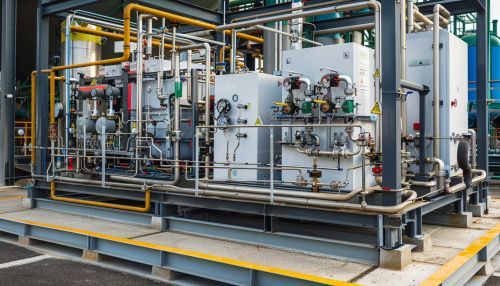Ostwald process
Overview
The Ostwald process is an industrial method for the production of nitric acid, a key chemical in the manufacture of fertilizers, explosives, and many other chemical products. This process was developed by the German chemist Wilhelm Ostwald in 1902 and has since become the primary method for nitric acid production worldwide. The process involves the catalytic oxidation of ammonia to nitrogen oxides, which are subsequently absorbed in water to produce nitric acid.
Historical Background
Wilhelm Ostwald, a Nobel laureate in Chemistry, developed the Ostwald process as a means to produce nitric acid more efficiently than previous methods. Before the advent of the Ostwald process, nitric acid was primarily produced through the Birkeland-Eyde process, which was energy-intensive and less efficient. Ostwald's method revolutionized the chemical industry by providing a more economical and scalable approach to nitric acid production.
Chemical Reactions
The Ostwald process consists of three main chemical reactions:
1. **Catalytic Oxidation of Ammonia:**
\[
4 \text{NH}_3 + 5 \text{O}_2 \rightarrow 4 \text{NO} + 6 \text{H}_2\text{O} \quad (\Delta H = -905.2 \text{ kJ/mol})
\]
This reaction is exothermic and occurs at high temperatures (around 900°C) in the presence of a platinum-rhodium catalyst.
2. **Oxidation of Nitric Oxide:**
\[
2 \text{NO} + \text{O}_2 \rightarrow 2 \text{NO}_2 \quad (\Delta H = -114 \text{ kJ/mol})
\]
This reaction takes place at lower temperatures (around 50°C) and involves the oxidation of nitric oxide to nitrogen dioxide.
3. **Absorption of Nitrogen Dioxide:**
\[
3 \text{NO}_2 + \text{H}_2\text{O} \rightarrow 2 \text{HNO}_3 + \text{NO}
\]
In this step, nitrogen dioxide is absorbed in water to form nitric acid and nitric oxide. The nitric oxide produced can be recycled back into the process.
Process Description
Ammonia Oxidation
The first step in the Ostwald process involves the oxidation of ammonia. Ammonia gas is mixed with air and passed over a platinum-rhodium catalyst at high temperatures. The exothermic nature of this reaction helps maintain the necessary temperature for the catalyst to function efficiently. The reaction produces nitric oxide and water vapor.


Nitric Oxide Oxidation
The nitric oxide generated in the first step is then cooled and mixed with additional oxygen to form nitrogen dioxide. This reaction occurs at a much lower temperature and is relatively slow compared to the initial oxidation of ammonia. The nitrogen dioxide formed is a reddish-brown gas and is highly reactive.
Absorption and Nitric Acid Formation
In the final step, nitrogen dioxide is absorbed in water in absorption towers. The absorption process is facilitated by the presence of water and results in the formation of nitric acid and nitric oxide. The nitric oxide produced in this step is recycled back into the oxidation stage to improve the overall efficiency of the process.
Catalysts and Reaction Conditions
The choice of catalyst and reaction conditions are critical to the efficiency of the Ostwald process. The platinum-rhodium catalyst used in the ammonia oxidation step is highly effective but also expensive. Efforts have been made to develop alternative catalysts that are less costly while maintaining high efficiency. The reaction conditions, including temperature, pressure, and gas composition, are carefully controlled to optimize the yield and purity of nitric acid.
Industrial Applications
Nitric acid produced via the Ostwald process is a crucial intermediate in the production of fertilizers, particularly ammonium nitrate and calcium ammonium nitrate. It is also used in the manufacture of explosives such as trinitrotoluene (TNT) and nitroglycerin. Additionally, nitric acid is employed in the production of various organic and inorganic chemicals, including dyes, plastics, and pharmaceuticals.
Environmental and Safety Considerations
The Ostwald process, like many industrial chemical processes, has environmental and safety implications. The high temperatures and reactive gases involved pose risks of explosions and toxic emissions. Proper safety measures, including the use of protective equipment and monitoring systems, are essential to mitigate these risks. Additionally, the release of nitrogen oxides (NOx) into the atmosphere can contribute to air pollution and acid rain. Modern plants incorporate scrubbers and other emission control technologies to minimize environmental impact.
Advances and Innovations
Recent advancements in the Ostwald process focus on improving catalyst efficiency, reducing energy consumption, and minimizing environmental impact. Research is ongoing to develop more sustainable catalysts that do not rely on precious metals. Innovations in reactor design and process optimization also aim to enhance the overall efficiency and sustainability of nitric acid production.
